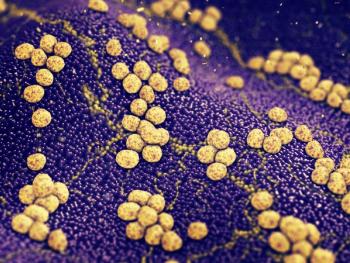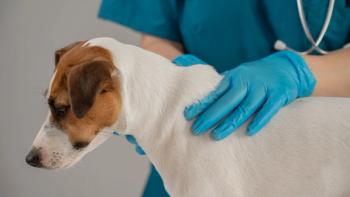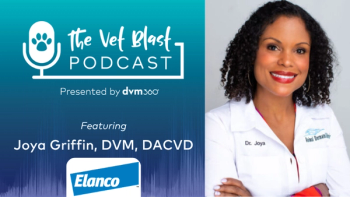
Resistant pyoderma (Proceedings)
Resident bacteria are normal inhabitants and are able to grow on normal skin.
Resident bacteria are normal inhabitants and are able to grow on normal skin. Prerequisite to infection is the process of bacterial adhesion, mediated through molecular interactions on the bacteria and the keratinocytes. For example, staphylococci surface adhesion molecules teichoic acid and protein A bind to host surface receptors fibronectin and vitronectin.
Resident flora of dogs includes: Micrococcus spp, coagulase-negative staphylococci, α-hemolytic streptococci, Clostridium spp, Propionibacterium acnes, Acinetobacter spp, and S.pseudintermedius. S.pseudintermedius, the most common skin pathogen of dogs, can be isolated from the oropharynx, nares and anal ring of normal dogs, from which it is believed to disseminate to susceptible cutaneous lesions.
Resident flora of cats include: Micrococcus spp, coagulase-negative staphylococci, α-hemolytic streptococci, S. aureus, S. pseudintermedius and Acinetobacter spp.
Transient bacteria do not grow well on normal skin. They may grow as secondary invaders of diseased skin. Transient flora of dogs include: E. coli, Proteus mirabilis, Corynebacteria spp., Bacillus spp., and Pseudomonas spp. Transient flora of cats include: α-hemolytic streptococci, E. coli, P. mirabilis, Pseudomonas spp, and Bacillus spp.
The most common clinical forms of pyoderma in the dog are superficial folliculitis and superficial spreading pyoderma. These forms are often associated with allergic skin diseases (atopic dermatitis, flea allergy dermatitis, or food hypersensitivity) and have traditionally responded well to empirical antibiotic choices. Cephalexin, potentiated amoxicillin, and sulfa drugs have been widely used in these cases for many years. Occasionally a patient would fail to respond to appropriate dosing of one of these antibiotics. In the absence of an identifiable underlying cause, they were classified as having idiopathic or recurrent pyoderma.
More recently, methicillin-resistant staphylococcal species have emerged as skin pathogens in dogs and cats. Deep bacterial folliculitis associated with Pseudomonas aeruginosa has also been described recently.
Other bacterial skin infections that may fail to respond to conventional antibiotic therapy incluce mucocutaneous pyoderma, deep pyoderma, and deep folliculitis and furunculosis, and opportunistic mycobacteriosis.
The emergence and recognition of these diseases emphasizes the importance of performing bacterial cultures in order to select effective antibiotic therapy.
Antimicrobial therapy
Topical agents: chlorhexidene, povidone-iodine, ethyl lactate, benzoyl peroxide, acetic acid, antibiotics (mupirocin, bacitracin, neomycin, polymyxin B).
Formulations: ointments, creams, sprays, shampoos, and rinses.
The choice of antibiotic for superficial pyoderma is often empirical. S. pseudintermedius has a fairly predictable susceptibility pattern. Clinical response to an antibiotic may be adversely influenced by relatively poor blood perfusion of the skin, α-lactamase production, intracellular bacteria, or scarring. Clinical response may not correlate well with susceptibility testing. Methicillin-resistant S. aureus, S. schleiferi, and S. pseudintermedius are a growing concern.
Antibiotics commonly prescribed for cutaneous infections
Immunomodulation/Immunostimulation
A variety of products are marketed and sometimes used in an attempt to normalize the immune function of dogs with recurrent pyoderma that are considered immunodeficient. Few controlled studies of treating pyoderma with these products have been reported. Purported benefits are generally non-specific and include enhancing cell mediated immunity.
Each of these products should be given concurrently with systemic antibiotic therapy until the pyoderma has resolved. The antibiotic is discontinued and the immunomodulator is continued long term.
• Staphage Lysate: S. aureus phage lysate for SC injection.
• ImmunoRegulin: killed Propionibacterium acnes preparation for IV injection.
• Autogenous staphylococcal bacterins: not widely used.
• Levamisole: 2.2 mg/kg q. 48 hrs.
• Cimetidine: 10 mg/kg TID.
• IFN-α: human recombinant form has been used at 1-3 million IU/dog po or sc q. 1-3 days.
Superficial bacterial infections
Acute moist dermatitis
• Clip away the matted hair. Clean with a gentle disinfectant (chlorhexidene). Sedation may be required for severe, painful lesions.
• Tailor medical therapy to the patient and lesion severity. You might prescribe a combination of the following:
• Non-steroidal antipruritic spray TID – QID x 7 d. (i.e. topical lidocaine or oatmeal containing product)
• Topical corticosteroid/antibiotic spray TID – QID x 7 – 10 d. (i.e. gentamicin/betamethasone)
• Oral prednisone (0.5-1.0 mg/kg SID, tapering schedule)
• Dexamethasone solution (0.1-0.2 mg/kg SC or IM)
• Antibiotic for 14-21 days
• Protective collar until itch-scratch cycle has been arrested
• Discuss a plan with the owner for controlling the underlying problem.
Impetigo
• Topical antibiotic ointment (mupirocin)
• Antibacterial shampoo (chlorhexidene, ethyl lactate, or benzoyl peroxide containing products)
• Systemic antibiotic for more severe or widespread puppy pyoderma and bullous impetigo
• Control predisposing conditions
Mucocutaneous pyoderma
• Topical antibiotic (mupirocin)
• Systemic antibiotic x 3-6 weeks.
Superficial bacterial folliculitis
• Treat as isolated episode or work up underlying conditions based upon the situation.
• Antibacterial shampoo therapy once to twice weekly.
• Systemic antibiotic for a minimum of 3 weeks.
Deep bacterial infections
Pyotraumatic folliculitis and furunculosis
• Same as acute moist dermatitis.
• More resistant to therapy.
• Antibiotic with efficacy against S. pseudintermedius should be continued 10-14 days after clinical cure.
• Discontinue prednisone as soon as possible (some would say not to give it at all).
Bacterial folliculitis and furunculosis
• Severe cases may require IV fluids and parenteral antibiotic therapy.
• Frequent bathing with antibacterial shampoo.
• Base initial antibiotic therapy on cytology results, change if necessary based on culture results.
• Length of treatment should be based on follow-up examinations and response to therapy. Treat 2-3 weeks past clinical cure, often 6-12 weeks.
Acute deep psuedomonal pyoderma
• Distinctive syndrome
• Dogs often presented for sudden onset of dorsal truncal pain
• Papules, hemorrhagic bullae, crusts and ulcers predominate
• Excellent response to fluoroquinolones
Nasal folliculitis and furunculosis
• Systemic antibiotic therapy for 7-14 days after clinical cure.
• Soak and clean lesions TID with chlorhexidene or Burrow's solution
Muzzle folliculitis and furunculosis
• Modify behaviors which predispose the chin to trauma, if possible.
• Mild cases may respond to regular antibacterial cleaning and/or topical antibiotic therapy.
• Infected cases should receive systemic antibiotic therapy for 4-6 weeks.
• Patients which heal with scarring and entrapped hair shafts may benefit from chronic topical corticosteroid treatment.
Interdigital pyoderma
• Chronic cases with scarring can be difficult to resolve
• If an underlying cause is detected, treat specifically
• Treat with systemic antibiotic for 6-8 weeks or 2 weeks past clinical resolution based on C & S results
• Topical therapy may include foot soaks with Burrow's solution, daily antibacterial shampoo therapy, and/or topical antibiotic ointments.
• Refractory cases may require surgical debridement and/or fusion podoplasty.
German shepherd dog pyoderma
• Treat underlying diseases if identified.
• Clip and clean matted and ulcerated lesions.
• Antibacterial shampoo therapy.
• Systemic antibiotic therapy for 8-12 weeks.
• Relapses are common and should be treated early and aggressively.
• Immunomodulation may be helpful.
• Chronic antibiotic therapy may be necessary in some cases.
Acral lick dermatitis and furunculosis
• Long-term (6-12 week) course of antibiotics may be required.
• Behavior modification (increase exercise, more attention).
• Amitriptyline, fluoxetine, and clomipramine are variably effective.
• Bitterants applied topically around the lesion.
• No single modality works in a high percentage of cases to eliminate licking behavior.
Bacterial pseudomycetoma
• Surgical excision
• Systemic antibiotic therapy based upon C & S
Feline leprosy
• Surgical excision when possible
• Dapsone, rifampin, or clofazamine may be of benefit
Opportunistic mycobacterial granuloma
• Surgical excision when practical.
• With or without surgery, antibiotic therapy is required.
• Utilize C & S data when available.
• Enrofloxacin, clofazamine, and doxycycline are good empirical choices.
• Months of treatment is usually necessary (4-6 weeks past clinical cure).
Actinomycosis
• Surgical excision
• Long-term (3-4 month), high dose penicillin, amoxicillin, or oxacillin.
• Guarded prognosis for resolution.
Actinobacillosis
• Surgical drainage and curettage.
• NaI, streptomycin, sulfonamides, tetracycline, or chloramphenicol for long periods
• Guarded prognosis
Nocardiosis
• Surgical drainage
• Choose long-term antibiotic therapy based on C & S results (organisms have variable susceptibility patterns).
• Sulfonamides when susceptibilities are not available.
• Antibiotic combinations may be necessary due to resistance.
• Guarded prognosis
Plague
• Gloves and masks should be used when handling patients and exudates.
• Therapy should begin before laboratory confirmation.
• 21 day course of antibiotic therapy: Gentamicin 6 mg/kg IV q.24h., TMS 15 mg/kg po/iv/im BID, Tetracycline 20 mg/kg TID, Chloramphenicol 15 mg/kg po/sc BID, Enrofloxacin 2.5 mg/kg bid.
Newsletter
From exam room tips to practice management insights, get trusted veterinary news delivered straight to your inbox—subscribe to dvm360.






